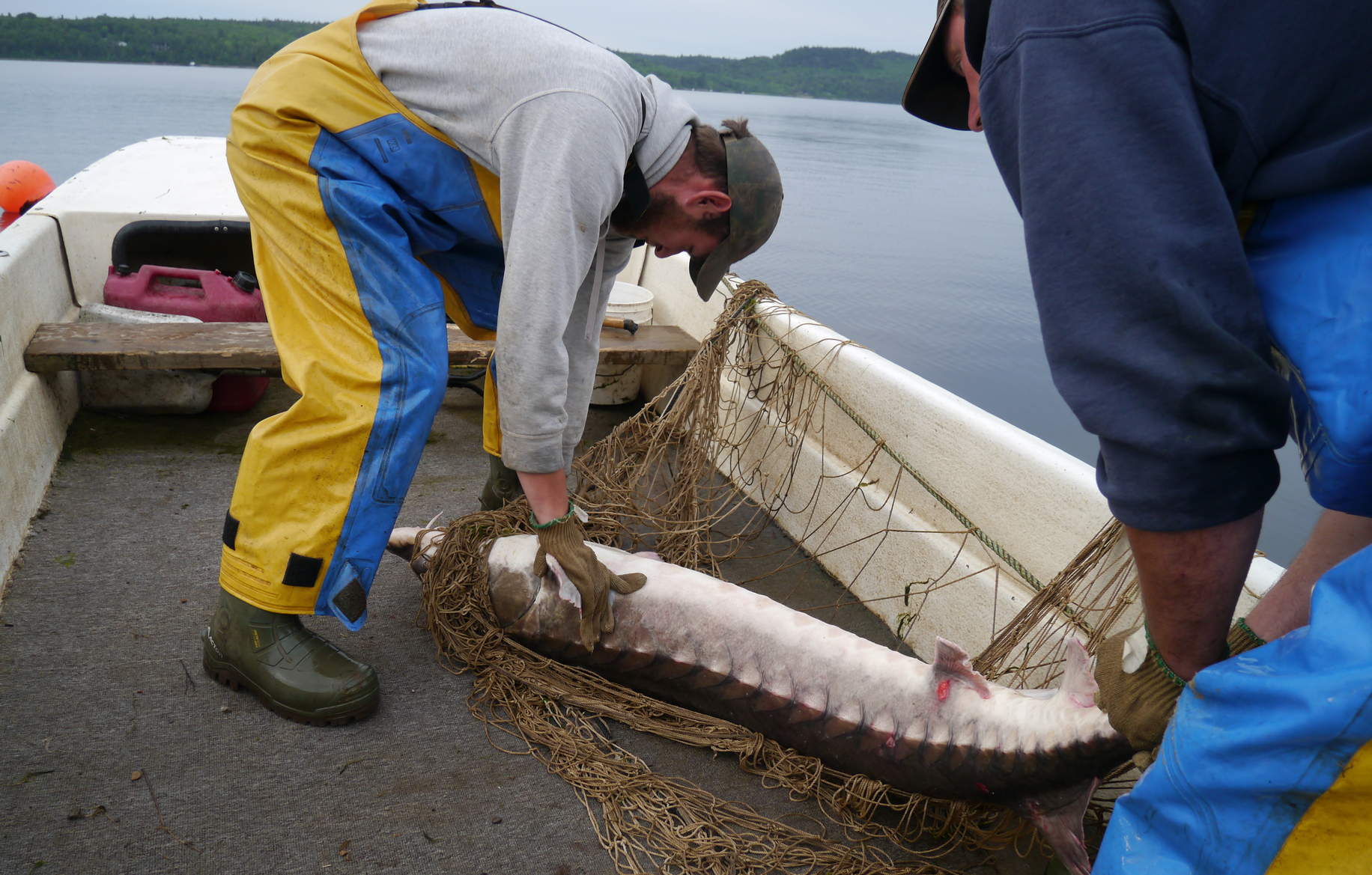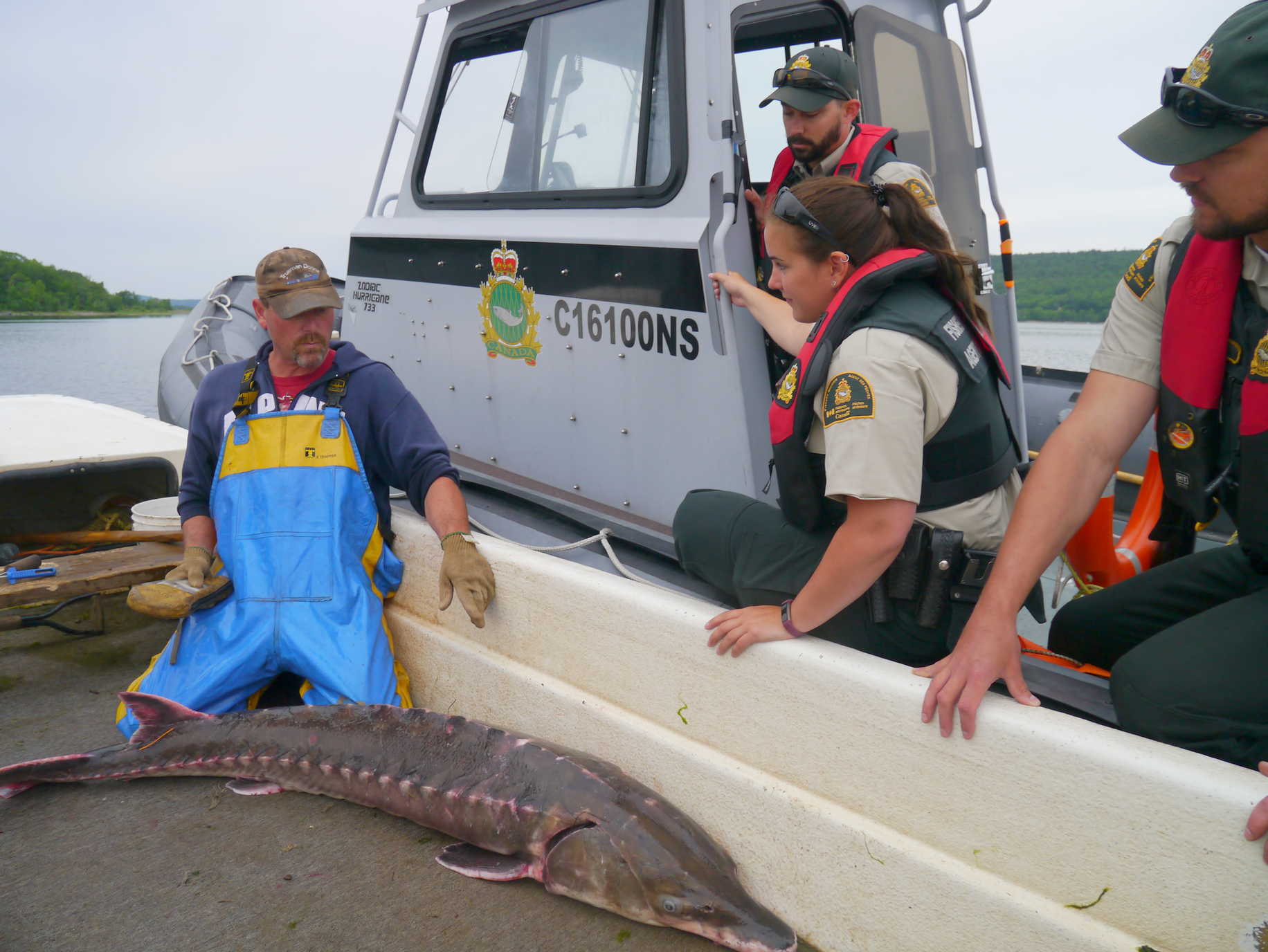
Cornel Ceapa (above left) knows his sturgeon. He earned a PhD in sturgeon biology from a university in his native Romania. He studied sevruga sturgeon, an overfished species that is critically endangered and on the verge of extinction. Now a Canadian citizen living in Saint John, New Brunswick, Ceapa is determined that the Atlantic sturgeon will not suffer the same fate. His company, Acadian Sturgeon and Caviar, Inc.(www.acadian-sturgeon.com/en), operates one of the last wild commercial sturgeon fisheries in the world. It also restocks the Saint John River with hatchery fish.
The company’s sturgeon meat appears on high-end menus in Montreal, Toronto, and Vancouver, and small amounts (along with caviar) are available at Saint John fishmongers. The caviar can also be ordered (in Canada only) directly from the company (https://acadian-sturgeon-and-caviar-inc.myshopify.com/). The company’s harvest is certified as sustainable by Ocean Wise, making the Acadian Wild Caviar the only wild, legal, and sustainable caviar harvested in the world.
Sturgeon and Caviar Safari
 Only four fishermen are licensed to harvest sturgeon in New Brunswick. David joined two of them on an all-day experience that’s called the Sturgeon and Caviar Safari. It includes a session on the river, a tour of the hatchery and processing facility, and an exquisite tasting experience. Sturgeon are the stuff of legend. In evolutionary terms, they are one of the oldest fish in existence. Instead of scales, their bodies carry a kind of armor plate called “scutes.” And they are so big that some “sea serpent” sightings were probably giant sturgeon. The “safari” experience offered by Acadian has been largely for chefs who want to better understand the fish, their habitat, how they are harvested, and how they are processed. This year, the company opened the tours (July only) to the general public.
Only four fishermen are licensed to harvest sturgeon in New Brunswick. David joined two of them on an all-day experience that’s called the Sturgeon and Caviar Safari. It includes a session on the river, a tour of the hatchery and processing facility, and an exquisite tasting experience. Sturgeon are the stuff of legend. In evolutionary terms, they are one of the oldest fish in existence. Instead of scales, their bodies carry a kind of armor plate called “scutes.” And they are so big that some “sea serpent” sightings were probably giant sturgeon. The “safari” experience offered by Acadian has been largely for chefs who want to better understand the fish, their habitat, how they are harvested, and how they are processed. This year, the company opened the tours (July only) to the general public.
David went out with Bill Ford and Bill Ford Jr (at top with Cornel Ceapa) in a river skiff on the Saint John River to check the four gillnets set in a brackish stretch of the river before it opens into the Bay of Fundy. Although sturgeon grow to huge lengths (up to 15 feet), Acadian Sturgeon and Caviar is very selective. The legal minimum length is 48 inches, but they only keep fish that measure at least 69-77 inches from nose to the V-notch of the tail. Females that size large yield large pockets of caviar along with the meat, and the males are large enough to produce big fillets. Small males and even big females that have already laid their eggs go back in the river. Any fish over 114 inches is also immediately returned. Every fish that doesn’t already have a ultrasonic tag is fitted with one.
Sturgeon are surprisingly easy to catch because they are slow-moving bottom feeders that suck up insects, small fry, and crustaceans off the river bottom. The Fords set their nets at shoals near the riverbanks, and the sturgeon become entangled. The hardest part of the harvest is hauling in a net with a 100- to 150-lb. fish in it.
Knowing every fish by name, or at least by number
 Even with only four licensed fishermen, the sturgeon fishery is strictly regulated. Our boat was carefully monitored by a Fisheries Canada vessel as we hauled fish aboard. The Fisheries boat pulled up alongside as the Bill Fords measured and recorded each fish. Those caught previously had implanted tags that identified them as either too small or having already laid eggs. After sexing the other fish and probing for roe, we selected two to harvest. One of the others was a new catch, so Bill Sr. implanted a tag in its dorsal fin. Swinging the rejected fish back and forth, the fishermen heaved each of them back into the river. We fired up the outboard motor and headed back to the hatchery and processing plant on Carter’s Point, across the river from Saint John. Cornel and his wife Dorina were preparing a feast of all things sturgeon. (See next post.)
Even with only four licensed fishermen, the sturgeon fishery is strictly regulated. Our boat was carefully monitored by a Fisheries Canada vessel as we hauled fish aboard. The Fisheries boat pulled up alongside as the Bill Fords measured and recorded each fish. Those caught previously had implanted tags that identified them as either too small or having already laid eggs. After sexing the other fish and probing for roe, we selected two to harvest. One of the others was a new catch, so Bill Sr. implanted a tag in its dorsal fin. Swinging the rejected fish back and forth, the fishermen heaved each of them back into the river. We fired up the outboard motor and headed back to the hatchery and processing plant on Carter’s Point, across the river from Saint John. Cornel and his wife Dorina were preparing a feast of all things sturgeon. (See next post.)
